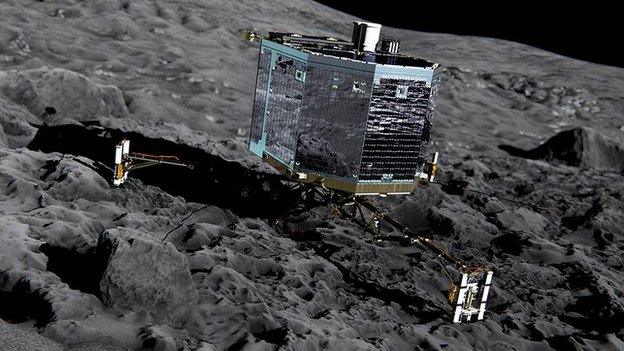Rosetta's target is 'double' comet
- Published

What is the history of Comet 67P? How did it come to take this form?
Europe's Rosetta probe has acquired some sensational new images of the comet it is chasing through space.
The pictures show that 67P/Churyumov-Gerasimenko appears to be not one but two objects joined together. It is what scientists call a "contact binary".
How the comet came to take this form is unknown.
It is possible that 67P suffered a major fracture at some point in its past; it is also possible the two parts have totally different origins.
What is clear is that the European Space Agency (Esa) mission team now has additional and unexpected considerations as it plans how to land on the comet later this year - not least, which part of the comet should be chosen for a touchdown?
The images in the sequence of nine were acquired last Friday.
They are an interpolation. That is, the "real" pictures are much more pixelated because of the thousands of km that still separate the probe and the comet. The outlines that you see have therefore been "smoothed" to make the scene easier to understand.
Rosetta's Osiris Narrow Angle Camera has a whole series of images that can be run together as a movie. This is expected to be released later this week.
With hindsight, there were indications in last week's official image release that something unusual might be about to unfold. But the idea that 67P could be a contact binary is a major surprise.
Rosetta is still refining its rendezvous with the comet, firing its thrusters weekly to bring itself into orbit on 6 August.
By that stage, the Esa probe should be no more than 70km from the surface of the 4.5km-wide ball of ice.
Once scientists understand better the gravitational field of 67P, the orbit will be lowered to about 30km.
It is that point that mapping can begin to select a touchdown zone for Philae - the small landing robot currently riding piggyback on Rosetta.
This historic touchdown is currently scheduled for 11 November.

Last week's official image release revealed a lobed object
Jonathan.Amos-INTERNET@bbc.co.uk and follow me on Twitter: @BBCAmos, external
- Published10 July 2014
- Published22 May 2014

- Published28 March 2014

- Published21 March 2014

- Published20 January 2014

- Published10 December 2013

- Published18 September 2013
- Published29 March 2012